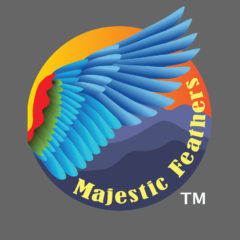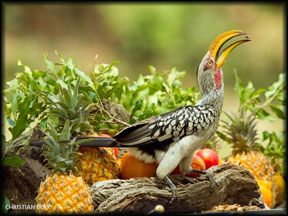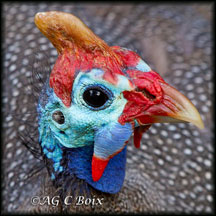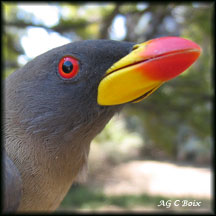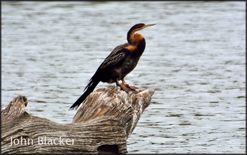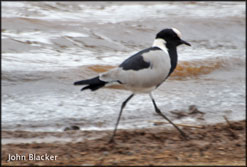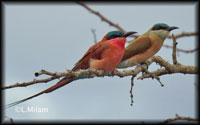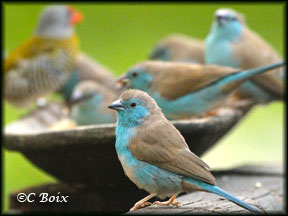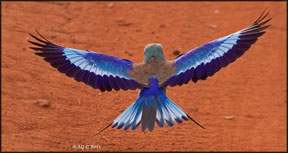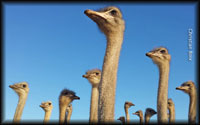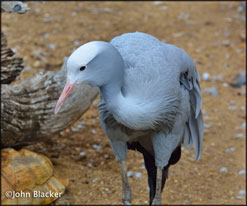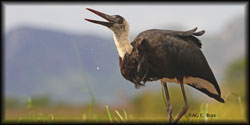BIRDING ADVENTURE – CAPE to KRUGER with Extension Drakensberg to DURBAN
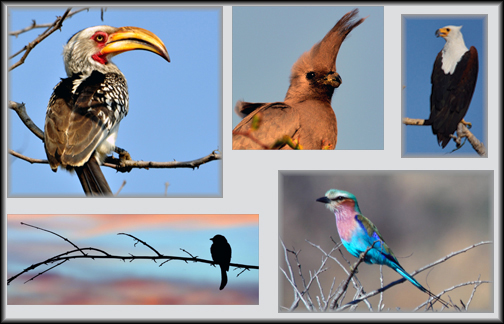
CAPE TO KRUGER October 19 to November 6, 2017
with
Barrier of Spears Extension Drakenberg to Durban Extension November 7 to 14, 2017
Reservation Deadline May 10, 2017 Email Us to Reserve Your Tour
(There are four spaces available on this tour.)
Cape to Kruger October 19 to November 6, 2017
(Depart the U.S. on October 19, arrive in Cape Town on October 20, 17 days of birding)
Double Occupancy price: $5,852 per person from Cape Town
No single supplement price is available.
This is an intimate tour limited to six birders
Drakenberg to Durban November 7 to November 13, 2017
(see departure details below)
Double Occupancy price: $2,250
Please note in order for the extension to go forward all 6 participants from the main tour must sign up. If less than 6 participants want to take the extension, the price can be recalculated.
The Barrier of Spears extension
(7 and a half days of birding. The tour ends in Durban the afternoon on November 13. From Durban participants take a domestic flight to Johannesburg for flights home. Participants arrive back in the U.S. on November 14)
CAPE TO KRUGER ITINERARY
Day 1 (Oct 19): Arrive in Cape Town
In-country guide: Christian Boix
Upon arrival in Cape Town we will transfer to a peaceful B&B in the suburbs. We will be based at this location for 3 days.
Day 2 or 3 (Oct 21 or 22): Pelagic (optional) (Please note: Day 2 and 3 can be reversed depending on the weather conditions)
The waters off of Cape Town from the port in Simon Town are regarded as one of the best pelagic spots in the world. Thousands of seabirds representing at least 15 to 20 species are the focus of the day. We expect amazing views of Black-browed, Shy and Yellow-nosed albatrosses, White-chinned Petrel, Cape Gannet and Sooty Shearwater, and there will be huge clouds of sea-going species to search through for less common species gliding and winging around our boat.
This trip is optional because it is weather dependent and may be canceled if we are unlucky with the weather. It is also optional because some participants my not wish to go. Those who opt not to do the pelagic trip will have a different program tailored to their needs at a slight additional cost–the cost of an extra bird guide for the day.
Day 2 or 3 (21 or 22): West Coast
Fantastic densities of shorebirds are found in a series of wetlands in the dry West Coast. Palaearctic waders abound in Langebaan Lagoon. The resident shorebirds that we will likely see here includes the scarce Chestnut-banded Plover. The nearby terrestrial habitat supports a nice variety of local specialties. The most sought after are; Black-Harrier, Southern Black Korhaan and Cape-Long-billed Lark.
Day 4 (Oct 23): Cape Peninsula to Hottentot’s Holland mountains
The Cape Peninsula is exceptionally beautiful. During the morning we will spend our time searching for fynbos endemics such as Orange-breasted Sunbird, Cape Sugarbird and Cape Siskin. Next we will bird Kommetjie, the home of the Benguela-endemic African Black Oystercatcher, and Bank, Crowned and Cape Cormorants.
After Kommetjie we head to the Cape of Good Hope. Along the way a stop will be made at Boulder’s Bay to hang out for a while with African Penguins. Our last stop for the day is Strandfontein where a series of ponds supporting a remarkable variety of waterfowl will keep us captivated.
In the afternoon, we search for Cape Rockjumpers, then we drive to our lodge in Hermanus.
Day 5 (Oct 24):Hottentot’s Holland to De Hoop Nature Reserve
Situated 125 miles east of Cape Town, the Agulhas plain stretches from the Langeberg Mountains to the southern tip of Africa. On this plain we’ll be birding to see the highly range-restricted Agulhas Long-billed Lark and Agulhas Clapper Lark. Some of the other spectacular specialties in this area are Blue Crane and Stanley’s Bustard.
We will overnight just outside De Hoop Nature Reserve.
Day 6 (Oct 25): De Hoop to Wilderness
Potberg mountain holds the regions last Cape Vulture breeding colony. We will spend the morning here. Some of the other target birds for the morning are the endemic Southern Tchagra, Pied Starling, Orange-throated Longclaw and Pearl-breasted Swallow.
In the afternoon we drive to Knysna exploring the Wilderness Lakes en-route. We will spend two nights in the quiet town of Wilderness.
Day 7 (Oct 26): Garden Route
The Garden Route winds over mountainsides dappled with fynbos flowers before it plunges into the thickly forested gorges where cola-hued rivers flow. Among the forest specialties we search for here are: Forest Buzzard, Knysna Turaco, Narina Trogon, Knysna and Olive Woodpeckers, Chorister Robin, Olive Bush Shrike, Swee Waxbill and Forest Canary.
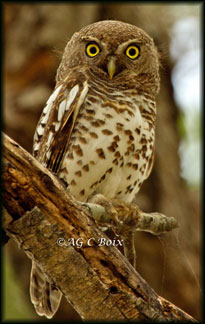
Day 8 (Oct 27): Garden Route to Karoo NP
Today we arise very early so that we can greet the dawn in the Swartberg Mountains where we will search for the skulking Victorin’s Scrub-Warbler, Cape Rock-Jumper, the rare Protea Canary and local Cape Siskin. While watching these birds we will be treated to views of dramatic rocky backdrops. From here we descend into the hot and arid Karoo National Park for a two-night stay.
Karoo National Park chalet accommodations.
Day 9 (Oct 28) : Karoo National Park
This park combines spectacular mountain scenery with the very best of Karoo birding; it is packed with Karoo endemics. The lowlands support Spike-heeled Lark, Gray-backed Finch-Lark, Karoo Chat, and Rufous-eared Warbler. In the Gorges of the park, the secretive Cinnamon-breasted Warbler, Pale-winged Starling, and Ground Woodpecker occur. The Sickle-winged Chat is found on the grassy plateau of the park and the newly described Karoo Long-billed Lark is common throughout the park.
Karoo National Park Chalet accommodations.
Day 10 (Oct 29): Karoo National Park to Johannesburg
We depart from Karoo and return to Cape Town, with birding along the way. In Cape Town we fly to Johannesburg. In Johannesburg we will overnight at a hotel away from this bustling city.
Days 11 & 12 (Oct 30 and 31) Wakkerstroom
In-country guide: Matt Prophet.
Some of Africa’s most threatened species occur in the area surrounding Wakkerstroom. In this area we will search for the critically endangered Rudd’s Lark, Botha’s Lark and Yellow-breasted Pipit. In the rolling grasslands we will comb through the blades looking for the magnificent endemics; Southern Bald Ibis, Blue Korhaan and Buff-streaked Chat. This vegetation is also home to widowbirds, francolins, cisticolas, weavers, bishops and whydas.
These two nights, Oct 11 and 12 will be spent in the quiet country town of Wakkerstroom.
Days 13,14 & 15 (Nov 1,2,3): Kruger National Park
We leave at the crack of dawn to make the most of our time at Kruger. Birding here is fantastic and many species live right in the park’s camps. The staccato calls of the Woodland Kingfisher and ridiculous moans for the Gray Go-away-bird reverberate throughout most lodgings. Elsewhere in the park Trumpeter Hornbills, Saddle-billed Storks, and White-crowned Lapwings forage on river banks while Nile Crocodiles watch from distant sandbanks. We will undoubtedly bump into countless numbers of large mammals while birding, including the possibility of Lion, Leopard, African Elephant, African Buffalo, and two species of rhinoceros. Nights will be spent at several birdy camps inside Kruger.
Kruger is a fairly busy national park and guaranteeing a camp depends mostly on how soon we can book rooms, but the main and preferred camps we generally try to book are Berg en Dal and Letaba or similar.
Day 16 (Nov 4): Kruger National Park to Kurisa Moya
Today we soak up the remainder of Kruger’s excellent birding and game viewing opportunities before we head out for Kurisa Moya.
Overnight at Kurisa Moya
Day 17 (Nov 5): Kurisa Moya Limpopo Province near Magoebaskloof
Today is a full day of birding in the Woodbush looking for some great special species such as: Cape Parrot, Black-fronted Bush-shrike, Orange Thrush, Green Twinspot, Bat-hawk and many other great birds!
Overnight at Kusia Moya
Day 18 (Nov 6): Back to Johannesburg
Today we will drive back to Johannesburg and say farewell to those leaving us. There will be birding along the way. Flights do not leave until that evening.
Those with the time and the stamina will continue on the extension (see below).
Overnight in Johannesburg or at Tambo City Lodge for those taking the extension.
Post EXTENSION / Nov 7 ending in Durban on Nov 13
DRAKENSBERG: THE BARRIER OF SPEARS ITINERARY
This 7.5-day extension takes in the spectacular Mkuze, St. Lucia, the Drakensberg Mountains and the midlands of Natal. This extension gives us chances at another suite of South African specialties. Important note: The extension begins in Johannesburg, and ends in Durban.
Day 1 (Nov 7): Johannesburg or Tambo City to Mkuze
Today we drive from Johannesburg or Tambo City (TBA) to the Mkuze Game Reserve area. Birding along the way.
Overnight in Mkuze Town.
Day 2 (Nov 8): Mkuze Game Reserve
Today we will spend a full day birding and exploring in one of Africa’s most famous reserves, Mkuze. This is where the White Rhino was saved from global extinction. Birding here is over the top and we can only hope to take in a fraction of the 420 bird species recorded here. Something special about this reserve is that many areas can be visited on foot, something we were not able to do in Kruger National Park. The highly diverse habitat here includes; pans, swamp forest, Acacia thronbush, woodland, riverine forest, and the unique sand forest. In the sand forest we will search for these specialties: Rudd’s Apalis, Pink-throated Twinspot and Neergaard’s Sunbird. The surrounding bush offers a spectacular number of birds including several kingfisher species, barbets, bushshrikes, helmetshrikes, rollers, cuckoos, robins,bulluls,starlings,sunbirds and seedeaters. Mkuzi is also renown as an excellent area for raptors and vultures because there are large predators in the park. We will very likely see many large mammals while birding here. There are 15 species of ungulates, and the possibility of predators such as leopard. Chances are good for White Rhinoceros as well. In the late afternoon we leave the reserve and head to St. Lucia.
Day 3 (Nov 9): St Lucia-Eshowe
After an early breakfast, we head directly to the small coastal hamlet of St. Lucia. In St. Lucia we will spend our morning taking in the incredible World Heritage Site at St. Lucia. The site is teeming with water birds and bushveld birds. We will explore stands of forest that skirt the lagoons edge searching for Green Coucal, Woodward’s Batis, Southern Banded Snake Eagle and Brown Robin. Other target birds include: Scaly-throated Honeyguide, Pink-backed Pelican, Wattle-eyed Flycatcher, White-eared Barbet, Gorgeous Bush Shrike, Narina Trogan, Woolly-necked Stork, Grey Waxbill, Grey Sunbird, Crested Guineafowl, Green Twinspot and Trumpeter Hornbill.
In the afternoon we will head to the coastal forests and mangroves that surround Richard’s Bay. Richard’s Bay is a fairly ordinary looking place that is loaded with top quality birding opportunities. In the broad open pans at Thulazihleka we may see the scarce Lesser Jacana as well as the special Brown-throated Weaver and Pale-crowned Cisticola. We will surely see African Jacana as well as White-backed Duck, Whiskered Tern, Osprey and several weaver species, widows, and water birds. Countless waders, terns, egrets, herons and other water birds occur in this magical and diverse lagoon. This area is also home to a good selection of mammals such as: Hippopotamus, Common Reedbuck, Burchell’s Zebra, Blue Wildebeest, Waterbuck, Vervet Monkey, Bushbuck, and the tiny Red Duiker. We will be looking for an African Finfoot before we head to Eshowe for the night.
Overnight in Eshowe.
Day 4 (Nov 10): Dhlinza
Dhlinza forest is a mystical place endowed with South Africa’s largest and most impressive canopy walkway. Our main target species here is the globally endangered and legendary cryptic Spotted Ground Thrush. It has the uncanny ability to blend with the leaf litter when it is not moving! There is another mega-specialty here as well, the Delegorgue’s Pigeon! The other great forest birds here are: Narian Trogan (our second chance), Scaly-throated Honeyguide, Forest Weaver, Black-headed Oriole, African Goshhawk, Green Twinspot, Terrestrial Bulbul and many more.
Overnight in Eshowe.
Day 5 (Nov 11) Umlalazi to Underberg
In the morning we head directly to the Umlalazi Nature Reserve seeking many forest birds before we head to Underberg for our “wings to the wind” major birding endeavor on the Lesotho Drakensberg the following day!
Day 6: (Nov 12) Sani Pass
This morning we head up the incredible Sani pass to 3482 m (the highest mountain pass in southern Africa) into the mountain kingdom of Lesotho (remember your Passport we will now be in a different country). Now we begin our search for the many specialties of the high Drakensberg. The rugged landscape here provides habitat for an astonishing variety of species including but not limited to: Bush Blackcap, Drakensberg Prinia, Yellow and Barratt’s Warbler, Buff-streaked Chat, Gurney’s Sugarbird, Cape Rock-Thrush, many grassbird species, Bearded and Cape Vulture, Drakensberg Siskin, Orange-breasted Rockjumper, Sentinel Rock-Thrush, Layard’s Titbabbler, Fairy Flycatcher, Mountain Pipits and scores more. The interesting and even bizarre mammals that we will see here include: Ice Rat, Chacma Baboon, and the Rock Hyrax locally known as the Dassie. Rock Hyrax is the closest relative of the elephant. With a bit of luck we could also see Eland, Mountain Reedbuck, Grey Rhebok and Klipspringer. An additional treat in this landscape are the Proteas, the South African flowering plants also known as “sugarbushes”.
Day 7 (Nov 13): Xumeni Forest and Midland Grasslands to Durban
The morning will be spent in the marvelous block of Afro-montane forest, this is Xumeni. Here will are looking for several exciting specialties including: Bar-throated Apalis, Blue-mantled Flycatcher, Starred and Chorister Robin, Yellow-throated Warbler and the very secretive Buff-spotted Flufftail and Orange Ground Thrush. It may take some patience to see the few remaining pairs of the recently split Cape Parrots but we will give it our all.
In the afternoon we will drive through the midland grasslands scouring the blades for the Wattled Crane, Long-crested Eagle and anything else we haven’t already seen. This is an excellent area for Oribi the increasingly scarce grassland antelope.
In the afternoon we head to Durban where the tour finishes. We say goodbye to our guide and board a domestic flight to Johannesburg. In Johannesburg we board our International flight for home, arriving back in the U.S. on November 14.
Email us today to reserve your tour!
INCLUDED IN THE PRICE OF THE TOUR: Tips to restaurant staff, accommodations from the night of day 1 to the night of day 17 if taking only the main tour. If also taking the extension, accommodations from the night of day 18 (Nov 6) to the night of day 6 (Nov 12). Flights out of Johannesburg for home will be scheduled at approx. 8 p.m. for both the main tour and the extension therefore lodging will not be needed on departure days. Meals from dinner on day 1 (unless the arrival time is too late for dinner service) to breakfast on the last day of either the main tour or the extension). Reasonable non-alcoholic drinks during meals, safe drinking water provided between meals while in the field. A PROFESSIONAL BIRD GUIDE with scope and audio playback gear throughout the tour. One arrival and one departure airport transfer per person on arrival and departure day respectively (transfers may be shared with other participants on the tour if they arrive at the same time, this is highly likely). Ground transportation for the group to all sites in the itinerary from day 2 to day 17 (and to day 7 if taking the extension). This tour will travel in a van and the bird guide will be driving. Entrance fee to all sites listed in the itinerary. One domestic flight from Cape Town to Johannesburg (day 10 Oct 29). A printed and bound checklist to keep track of your sightings.
NOT INCLUDED IN THE PRICE OF THE TOUR: Airfare from your home to the established international flight leaving the U.S. to Johannesburg to Cape Town, airfare from Durban to Johannesburg at the end of the tour in Durban, then Johannesburg to your point of origin in the U.S. Please note: Majestic Feathers will refer you to a travel agency at least 90 days before departure to book your flights. Do not book flights until you are a confirmed participant and you have been referred to the agent. Also not included, optional tips to the bird guide tour leader; tips for luggage porters (if you require their services); snacks, additional drinks apart from those included; alcoholic beverages; travel insurance (including medical emergency and medical evacuation are mandatory for this tour); excursions not included in the tour itinerary; extras at hotels such as laundry service, minibar, room service, telephone calls, and personal items, medical fees; excess baggage fees; other items or services not specifically mentioned as being included.
Please note: Currently the airfare described falls in the range of $1,600 to $1,800 for the travel from the U.S. to S. Africa and back. Currently the flight from Durban to Johannesburg is $100.
TRIP CONSIDERATIONS
PACE: Moderate-intense. In October and November the temperatures are pleasant and rarely interfere with birding. Generally birding begins at 5:30 a.m. and continues until about 6 p.m. Where possible we will use the middle of the day to rest up, but on many days we will use this time to travel between locations. There will be a few optional outings after dark to search for mammals, owls and nightjars; these are normally done just after dinner and seldom last for more than 2 hours. South Africa is a reasonably large country and there is a lot of driving involved(but the roads are good), there are a couple of days that include 5-6 hour drives. On at least 3 days we will be carrying packed lunches, but most meals will be sit-down affairs.
PHYSICAL DIFFICULTY: Easy. Almost all the birding is from mostly flat roads or tracks, or from the vehicle. The maximum walking on any day is likely around 2 miles.
CLIMATE: Lovely and warm, some mornings can be coolish, but overall the weather is a delight with temperatures ranging from 47 to 72 degrees over the course of the day.
ACCOMMODATIONS: Very good to excellent, all rooms have private, en-suite bathrooms, and full-time hot water. Electricity is available everywhere 24 hours a day. Internet is widespread, but not available everywhere.
PHOTOGRAPHY: If you are a casual photographer, you will love this trip! Birds are cooperative, and mammals are easy to take pictures of, and because we are visiting many places where birds are common, tame and easily seen, there are plenty of opportunities for the casual photographer to enjoying shooting. It is important to be aware that this is primarily a birding tour, so if you are a serious photographer, you may wish to consider a more dedicated photo tour.
TRAVEL REQUIREMENTS: A valid passport is required; the passport must be valid for at least six months past your intended stay. Tourist visas are currently not required for citizen of the U.S., Canada, UK, Australia, New Zealand, and most European countries. Visas are currently only required of a few nationalities, mostly Asian, Africa, and the Middle East. Travel requirements are subject to change; if you are unsure please check your governments website for the most recent information.
Confirmed Participants: Will receive details of payment dates and amounts and a sign up packet.
Flights: Confirmed participants will receive information about booking flights. Participants must not book flights until notified by Majestic Feathers staff to do so.
Travel Insurance: Trip cancellation insurance is highly recommended. Medical travel insurance is mandatory.
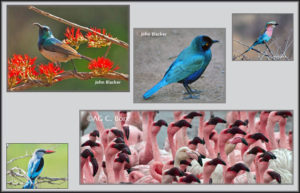
To Have Your Contact Information Added To Our Contact List For Notification Of Tours Click Here!
